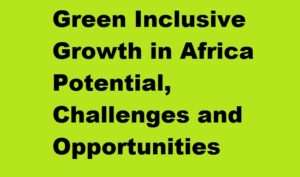النمو الاحتوائى الأخضر
استخدم مفهوم التنمية المستدامة على نطاق واسع منذ قمة ريو الأولى في تسعينيات القرن الماضى، والتي أعلنت أن التنمية يجب أن تكون مستدامة، ولكى يتحقق ذلك، فإنه يجب دمج البيئة مع الأبعاد الاقتصادية والاجتماعية والثقافية. وعلى الرغم من النمو الاقتصادي العالمي المتحقق خلال العقدين الماضيين، فان ثمار هذا النمو لم توزع بشكل عادل ولازالت العديد من اقاليم العالم تعانى من ارتفاع معدلات الفقر بها.وقد كان عام 2015 هو الموعد النهائى لتحقيق الاهداف الانمائية للالفية ، كما انه كان نقطة الانطلاق فى تدشين حملة التنمية لما بعد عام 2015 ، والعمل فى مجال تغير المناخ بما يهدف الى القضاء على الفقر وتحسين حياة الافراد والانتقال الى اقتصاد قائم على انخفاض انبعاثات الكربون وقادر على التكيف مع تغير المناخ .

ولقد تم اعتماد الاهداف الانمائية المستدامة Sustainable Development Goals(SDGs) رسمياً للعمل بها ابتداء من عام 2016 ، وهى سلسلة من الاهداف سوف تستخدمها الدول الاعضاء بالامم المتحدة خلال الفترة (2016-2030).ومع الإعلان عن تلك الأهداف ، بدأت العديد من الدول فى تبني استرتيجيات تنموية جديدة تركز على ما يسمى النمو الاحتوائى الاخضرInclusive Green Growth”“.
وفى ضوء ما تقدم ، تهدف هذه الورقة الى قياس النمو الاحتوائى الأخضر فى القارة الافريقية وتطور مؤشراته ، وتحديد مدى امكانية استخدامه كاداة للحد من الفقر المدقع وتحقيق العدالة الاجتماعية والحفاظ على البيئة ، وكذلك عرض اهم التحديات التى تواجه عملية التحول نحو مفهوم النمو الاحتوائى الأخضر بالقارة الافريقية ، والفرص التى يتيحها تطبيق هذا المفهوم. ولتحقيق تلك الاهداف , تم تقسيم الورقة الى عدد من المحاور على النحو التالى :
- مقدمة.
اولاً: اطار نظرى حول مفهوم النمو الاحتوائى الاخضر وطرق قياسه .
ثانياً: تحليل مؤشرات النمو الاحتوائى الاخضر فى القارة الافريقية .
ثالثاً: سياسات وبرامج تحقيق النمو الاحتوائى الاخضر بالقارة الافريقية .
رابعاً: فرص وتحديات الانتقال لمسار النمو الاحتوائى الشامل بافريقيا SWOT Analysis))
خامساً: خاتمة وتوصيات .
د.نهلة احمد أبو العز
أستاذ الاقتصاد المساعد بقسم السياسة والاقتصاد – جامعة القاهرة
التبادل التجارى بين مصر ودول حوض النيل
Green Inclusive Growth in Africa Potential, Challenges and Opportunities
The concept of sustainable development has been widely used since the first Rio Summit in the nineties of the last century, which declared that development must be sustainable, and for this to happen, the environment must be integrated with economic, social and cultural dimensions. Despite the global economic growth achieved during the past two decades, the fruits of this growth have not been distributed fairly and many regions of the world are still suffering from high poverty rates.2015 was the deadline for achieving the Millennium Development Goals, and it was the starting point in launching the post-2015 development campaign, and working on climate change with the aim of eradicating poverty, improving people’s lives and moving to a low-emissions economy. carbon and able to adapt to climate change .
The Sustainable Development Goals (SDGs) have been formally adopted for implementation starting in 2016, a series of goals that will be used by UN member states during the period (2016-2030).
In light of the above, this paper aims to measure green inclusive growth in the African continent and the development of its indicators, and to determine the extent to which it can be used as a tool to reduce extreme poverty, achieve social justice and preserve the environment, as well as present the most important challenges facing the transition process towards the concept of green inclusive growth in the African continent, and the opportunities offered by the application of this concept. To achieve these goals, the paper was divided into a number of axes as follows:
Introduction.

First: A theoretical framework on the concept of green containment growth and methods of measuring it.
Second: Analysis of green inclusive growth indicators in the African continent.
Third: Policies and programs to achieve green inclusive growth in the African continent.
Fourth: Opportunities and Challenges of Transition to the Path of Inclusive Growth in Africa (SWOT Analysis)
Fifth: Conclusion and recommendations.